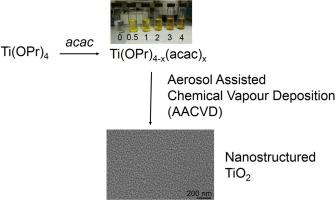Journal of Photochemistry and Photobiology A: Chemistry ( IF 4.3 ) Pub Date : 2020-06-26 , DOI: 10.1016/j.jphotochem.2020.112727 Megan Taylor , Robert C. Pullar , Ivan P. Parkin , Clara Piccirillo

|
Titanium dioxide is a compound of great interest, due to its functional properties; one of its most important uses is as a photocatalyst. TiO2 coatings can be deposited using different techniques. Aerosol Assisted Chemical Vapour Deposition (AACVD) is particularly interesting, as high temperature or pressure are not necessary to generate the gaseous precursors. Furthermore, by carefully choosing the deposition conditions (i.e. deposition temperature, solvent), it is possible to obtain deposits with different morphology and, consequently, different functional properties. In this paper we present the synthesis of titanium dioxide coatings with AACVD using complexes between titanium isopropoxide (TIPP) and acetyl acetone (acac) as precursors. Deposition experiments were performed using different ratios of TIPP to acac, to assess the effect on the composition of the coatings, their morphology and photocatalytic activity. Results showed that the use of acac led to nanostructured titanium dioxide (nanoparticles of about 10−25 nm diameter). Raman analysis showed the presence of both anatase and rutile phases. XPS analysis indicated the presence of residual carbonaceous species in the coatings; despite this, they displayed photocatalytic properties similar or superior to AACVD films without carbon. Photocatalytic tests, performed measuring the Formal Quantum Efficiency (FQE) and the Formal Quantum Yield (FQY) in the degradation of resazurin, showed that a acac:TIPP ratio equal to 1 led to the material with the highest performance, as the FQE value was about three times higher than that for the coating prepared with TIPP alone. Overall the complexes between TIPP and acac are promising precursors for the AACVD technique, leading to nanostructured coatings with enhanced performance.
中文翻译:

通过气溶胶辅助化学气相沉积(AACVD)制备的纳米结构二氧化钛涂层
二氧化钛由于其功能特性而备受关注。其最重要的用途之一是作为光催化剂。可以使用不同的技术来沉积TiO 2涂层。气溶胶辅助化学气相沉积(AACVD)特别令人感兴趣,因为高温或高压对于生成气态前体不是必需的。此外,通过仔细选择沉积条件(即沉积温度,溶剂),可以获得具有不同形态和因此不同功能特性的沉积物。在本文中,我们介绍了使用异丙醇钛(TIPP)和乙酰丙酮(acac)之间的配合物通过AACVD合成二氧化钛涂层的方法)作为前体。使用不同比例的TIPP与acac进行沉积实验,以评估对涂层组成,形貌和光催化活性的影响。结果表明,acac的使用可产生纳米结构的二氧化钛(直径约10-25 nm的纳米颗粒)。拉曼分析表明存在锐钛矿相和金红石相。XPS分析表明涂层中存在残留的碳质物质。尽管如此,它们仍显示出与无碳AACVD膜相似或更好的光催化性能。通过光催化试验测量刃天青素降解中的形式量子效率(FQE)和形式量子产率(FQY),结果表明acac:TIPP比率等于1导致材料具有最高的性能,因为FQE值比仅使用TIPP制备的涂层高出三倍。总体之间的配合TIPP和乙酰丙酮是有希望的前体的AACVD技术,导致纳米结构涂层具有增强的性能。



























 京公网安备 11010802027423号
京公网安备 11010802027423号